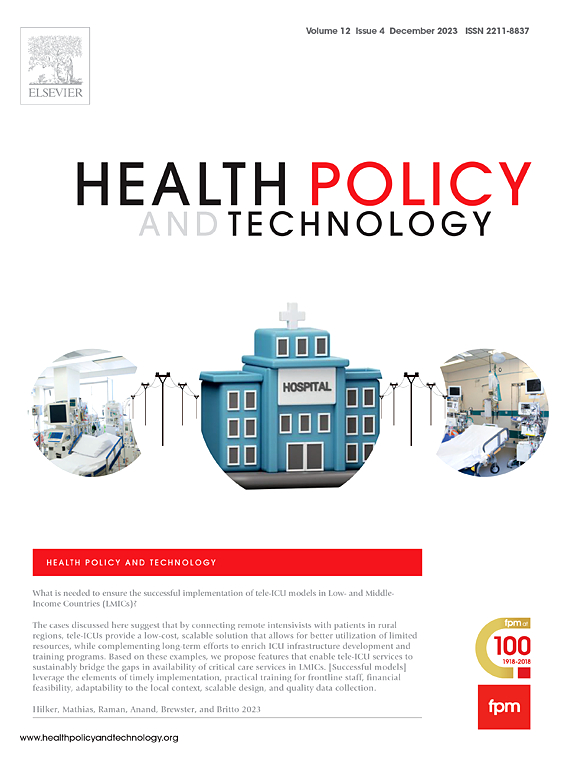重庆市儿童医疗保险覆盖率及影响因素分析
IF 3.7
3区 医学
Q1 HEALTH POLICY & SERVICES
引用次数: 0
摘要
目的了解中国现行医疗保险制度框架下不同类型儿童医疗保险的覆盖率及其影响因素,为制定儿童医疗保险政策提供依据。方法采用两阶段分层整群抽样方法对重庆地区的数据进行横断面研究。研究人群包括4705名9-13岁的儿童。保险状况分为三类:双重保险(基本医疗保险(BMI)和商业医疗保险(CMI))、单一保险(BMI或CMI)和无保险。结果28.25%的人有双重保险,56.58%的人有单一保险,15.18%的人没有保险。多因素logistic回归分析显示,与父母同住、父亲教育程度高、父母婚姻状况(未婚或再婚)、学业压力低、接触二手烟、体重超标、剖宫产与医疗保险覆盖率呈正相关。相反,内向性格(OR=0.14, P <;dual为0.001;OR=0.32, P <;单覆盖组为0.001)和近期感冒发生率(OR=0.72,双覆盖组P = 0.009;OR=0.77, P = 0.021(单一保险)与保险覆盖率呈负相关。值得注意的是,儿童的外向性和高家庭收入与双重保险覆盖率呈正相关。年龄较小的儿童更容易发生单次心肌梗死,但父母的高期望与此呈负相关。结论重庆市儿童心肌梗死覆盖率不足。建议对高风险群体实施有针对性的干预措施,包括来自低收入或单亲家庭的儿童、有潜在健康问题的儿童和留守儿童。这些措施旨在减轻家庭经济负担,促进儿童健康公平。你们的研究显示,虽然84.82%的儿童有某种形式的医疗保险,但56.58%的儿童有单一保险,15.18%的儿童没有保险。目前重庆市儿童各类保险的覆盖范围不足。我们的研究强调了健康行为、医疗保健利用和保险决策之间复杂的相互作用。政府应优先了解影响儿童参加保险的因素,并加强对儿童医疗保险的支持。本文章由计算机程序翻译,如有差异,请以英文原文为准。
Coverage rate and impact factors of children’s medical insurance in Chongqing
Objective
To investigate the coverage rates and influencing factors of different types of medical insurance (MI) for children in current health insurance system framework of China and provide evidence for MI policies.
Methods
We conducted a cross-sectional study using data from Chongqing collected through a two-stage stratified cluster sampling method. The study population included 4705 children aged 9–13 years. Insurance status was categorized into three groups: dual coverage (both basic medical insurance (BMI) and commercial medical insurance (CMI), single coverage (either BMI or CMI), and no insurance coverage.
Results
Among participants, 28.25 % had dual insurance, 56.58 % had single MI, and 15.18 % were uninsured. Multivariate logistic regression analysis revealed that co-residence with parents, higher paternal education level, parents' marital status (intact or remarried), low academic pressure, secondhand smoke exposure, overweight status, and cesarean section birth were positively associated with medicine insurance coverage. Conversely, introverted personality (OR=0.14, P < 0.001 for dual; OR=0.32, P < 0.001 for single coverage) and recent incidence of cold (OR=0.72, P = 0.009 for dual; OR=0.77, P = 0.021 for single coverage) showed negative associations with insurance coverage. Notably, children's extroversion and high family income were positively correlated with the dual insurance coverage. Younger children more likely to have single MI, but parents' high expectations showed a negative correlation.
Conclusion
The coverage rate of children's MI in Chongqing remains inadequate. It is advisable to implement targeted interventions for high-risk groups including children from low-income or single-parent families, those with underlying health issues, and left-behind children. These measures aim to reduce household financial burden and promote children's health equity.
Summary
Our research revealed that while 84.82 % of children had some form of medical insurance, with 56.58 % having single coverage and 15.18 % remaining uninsured. The coverage of various types of insurance for children in Chongqing is currently inadequate. Our study underscores the complex interplay between health behaviors, healthcare utilization, and insurance decisions. The government should prioritize understanding the factors that influence children's participation in insurance programs and enhance support for children's medical insurance.
求助全文
通过发布文献求助,成功后即可免费获取论文全文。
去求助
来源期刊

Health Policy and Technology
Medicine-Health Policy
CiteScore
9.20
自引率
3.30%
发文量
78
审稿时长
88 days
期刊介绍:
Health Policy and Technology (HPT), is the official journal of the Fellowship of Postgraduate Medicine (FPM), a cross-disciplinary journal, which focuses on past, present and future health policy and the role of technology in clinical and non-clinical national and international health environments.
HPT provides a further excellent way for the FPM to continue to make important national and international contributions to development of policy and practice within medicine and related disciplines. The aim of HPT is to publish relevant, timely and accessible articles and commentaries to support policy-makers, health professionals, health technology providers, patient groups and academia interested in health policy and technology.
Topics covered by HPT will include:
- Health technology, including drug discovery, diagnostics, medicines, devices, therapeutic delivery and eHealth systems
- Cross-national comparisons on health policy using evidence-based approaches
- National studies on health policy to determine the outcomes of technology-driven initiatives
- Cross-border eHealth including health tourism
- The digital divide in mobility, access and affordability of healthcare
- Health technology assessment (HTA) methods and tools for evaluating the effectiveness of clinical and non-clinical health technologies
- Health and eHealth indicators and benchmarks (measure/metrics) for understanding the adoption and diffusion of health technologies
- Health and eHealth models and frameworks to support policy-makers and other stakeholders in decision-making
- Stakeholder engagement with health technologies (clinical and patient/citizen buy-in)
- Regulation and health economics
 求助内容:
求助内容: 应助结果提醒方式:
应助结果提醒方式:


